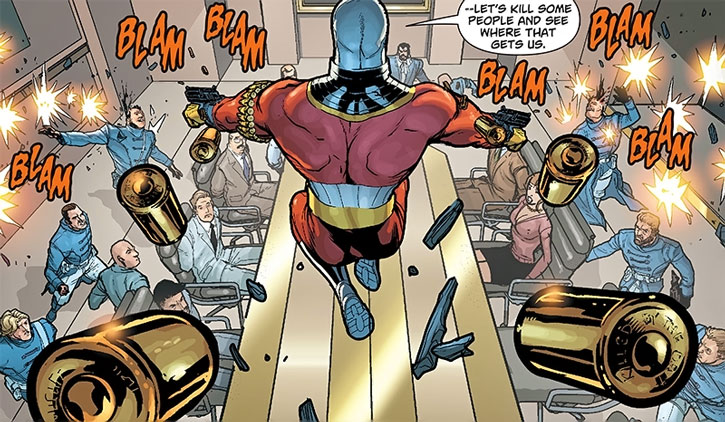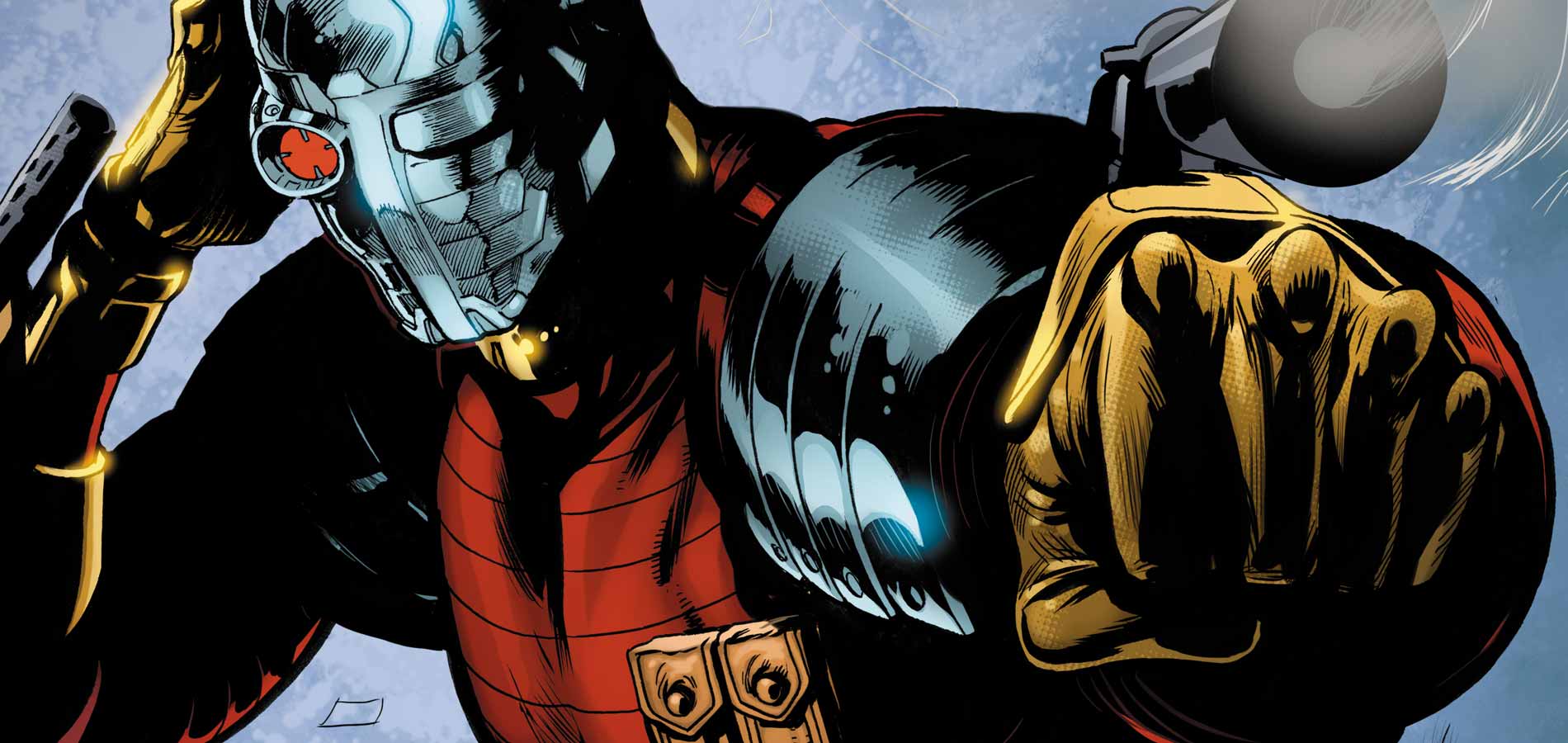
Over the past few years, DC Comics’ chain-smoking master assassin Deadshot, one of Batman’s second-tier rouges, has gained popularity—appearing in more comic books than ever and in multiple TV and cinema incarnations, notably portrayed by Will Smith in David Ayer’s high-grossing but critically-panned Suicide Squad (2016). Say what you will about Ayer’s film or Smith’s portrayal, it’s nice to see Deadshot finally get his due. He is pretty damn cool and quite fascinating, especially when you deconstruct his serial killer psyche in a way not dissimilar to something seen in the Mindhunters TV show. In 2009, IGN ranked Deadshot in its Top 50 Greatest Comic Book Villains of All Time. Despite Deadshot’s growing popularity he still seems to sometimes get confused with the popular character Deathstroke, DC’s other top marksman and hitman, who happens to wear a similar costume as well. Some fans might be surprised to learn that Deadshot actually pre-dates Deathstroke by a full thirty years, first appearing in the pages of Batman comics way back in 1950. (Deadshot also pre-dates Marvel’s similarly-styled highly-popular assassins-for-hire characters Deadpool and Bullseye by forty-one years and twenty-six years, respectively.) It’s clear to see that Deadshot has influenced many creators over the years. Without Deadshot, who knows whether or not we’d even have Deathstroke, Bullseye or Deadpool.

DC Comics is ushering in 2018 with a special New Year’s Eve story in Trinity Vol. 2 #16 (by Rob Williams, V Ken Marion, Sandu Florea, and Dinei Ribeiro) featuring a team-up of Batman, Superman, Wonder Woman, and Deadshot (read TBU’s review here). Let’s join in the fun and help DC celebrate the season by honoring 68 years of the man they call Deadshot! Because Deadshot has been around for such a long amount of time, there’s a lot of material featuring the character and there’s a lot to be said about him.
This first part of this piece will look at Deadshot’s canonical chronology from his Golden Age debut in 1950 up until the end of John Ostrander’s fantastic run on Suicide Squad in 1992. The second part of this piece will examine the chronological narrative history of Deadshot from 1993 up to the New 52 Flashpoint reboot in 2011. The third part of this piece will look at Deadshot’s chronological New 52 and Rebirth appearances, meaning all his comic book appearances from 2011 to now.

Deadshot has come a long way since the 50s, that’s for certain—especially when it comes to synergistic transmedia appearances. He’s appeared in numerous TV shows and movies over the years. Michael Rosenbaum voiced him in the animated Justice League and Justice League Unlimited TV shows. Tom Kenny provided a voice for him in the animated Batman: The Brave and The Bold TV show. Christian Slater voiced him in the animated Justice League Action TV show. In regard to live-action TV appearances, Bradley Stryker played Deadshot on Smallville while Michael Rowe played him on Arrow and The Flash. In film, Jim Meskimen voiced the character in the animated Batman: Gotham Knight while Neal McDonough voiced him in the animated Batman: Assault on Arkham. Deadshot also briefly appears (without speaking) in the animated Superman/Batman: Public Enemies film. Deadshot also appears in at least eight video games. Most famously, as mentioned above, Will Smith played Deadshot in Suicide Squad.
 But where did it all start for Floyd Lawton? What’s the full story? It started, as we’ve already said, in 1950—with good ol’ American sequential art. Let’s take a gander at the long and amazing chronological history of DC Comics’ Deadshot, shall we?
But where did it all start for Floyd Lawton? What’s the full story? It started, as we’ve already said, in 1950—with good ol’ American sequential art. Let’s take a gander at the long and amazing chronological history of DC Comics’ Deadshot, shall we?
Lew Sayre Schwartz (with David Vern Reed) creates Deadshot for the June-July 1950 issue of Batman #59. (Schwartz, a longtime DC illustrator and Bob Kane’s primary ghost artist, also created Killer Moth and Mad Hatter.) Deadshot’s secret identity is Floyd Lawton, a debonaire wealthy socialite not unlike Bruce Wayne. While Bruce and Dick are away on vacation, Floyd snaps on a domino mask and debuts as a gun-toting tuxedo-clad superhero, quickly becoming the toast of the town—so much so that Commissioner Gordon puts a Bulls-eye Signal on the police headquarters roof right next the to Bat Signal! Upon meeting Deadshot, Batman and Robin are immediately suspicious of Gordon’s new golden boy. After working a few cases with Deadshot, Batman and Robin are able to figure out his secret ID and his true intentions: to become ultimate crime lord of Gotham. Before setting up a ruse to lure Deadshot into a confrontation, Batman rigs the sniper’s guns so that they won’t aim correctly. During the ensuing confrontation, Deadshot is shocked to have missed his target—something he’s never done before. In shambles, Batman exposes him as a fraud and sends him to jail.
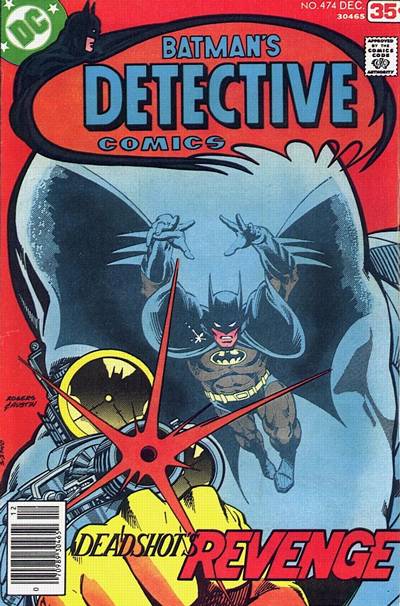
Deadshot next makes a cameo in Detective Comics #169 (by Lew Sayre Schwartz, Bob Kane, and Charles Paris, March 1951), which sees Batman, serving as temporary warden of Gotham State Prison, checking-in on Floyd in his cell. This is a fun little appearance that most of the internet seems to be unaware of.
It’s not until the Silver Age that we see Deadshot again, specifically in Steve Englehart and Marshall Rogers’ superb classic “Strange Apparitions” arc. In Detective Comics #474 (Steve Englehart, Marshall Rogers, Terry Austin, and Jerry Serpe, December 1977), we are introduced to the more recognizable version of the character as Floyd debuts his signature red-and-gray assassin costume complete with wrist-mounted guns—although, thanks to the magic of flashbacks, Deadshot’s tuxedo-wearing origin story is canonized for the Silver Age. Englehart and Rogers designed Deadshot’s wrist guns based on real life “sleeve guns” manufactured during World War II by the British Army. Breaking out of jail, Deadshot adds his signature laser-monocle to his new costume, which is actually a gizmo he steals from Penguin! The next day, at the Gotham Convention Center, Bruce meets with paramour Silver St. Cloud and Commissioner Gordon. By night, Batman is fighting Deadshot, who wants revenge, at the convention center, which features an exhibit of old-school Golden Age-style oversized items. Deadshot’s revenge plot fails as he is defeated by Batman.
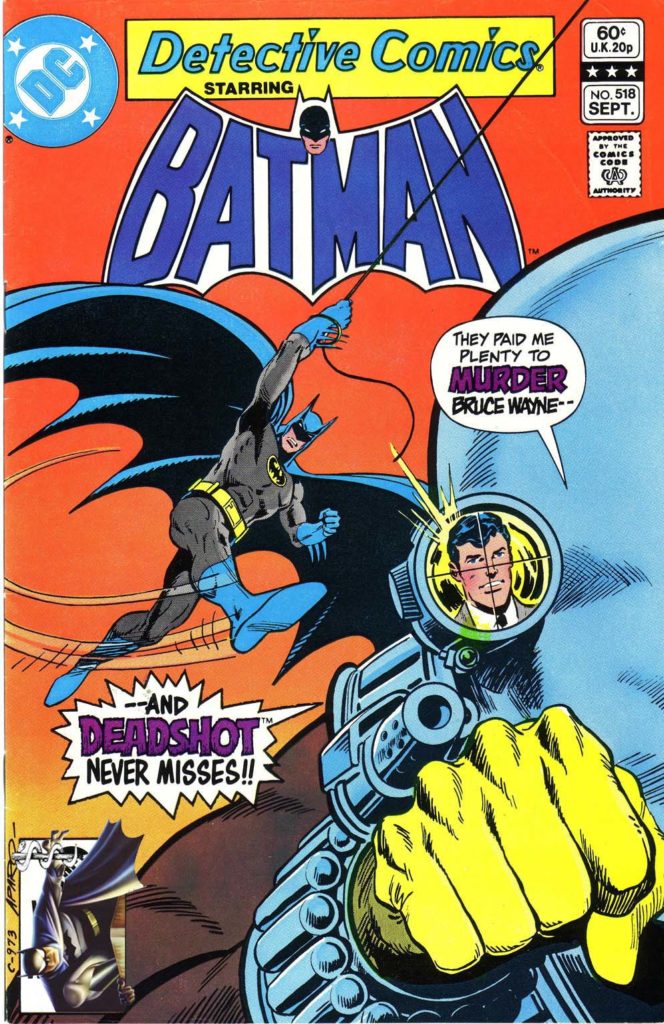 In the follow-up—Batman #351 (by Gerry Conway, Paul Levitz, and Gene Colan September 1982), Detective Comics #518-520 (by Conway, Levitz, and Don Newton, September 1982-November 1982), and Batman #354 (by Conway and Newton, December 1982)—Deadshot gets out of prison thanks to help from crime boss Rupert Thorne and corrupt government officials, including a crooked prison warden, Commissioner Peter Pauling (who has replaced Gordon), and Mayor Hamilton Hill. Accepting a hit on Bruce Wayne, Deadshot stalks his victim, who is actually Christopher Chance aka The Human Target, an amazing Len Wein/Carmine Infantino character that mimics would-be victims in order to turn the tables on their would-be assassins. Shortly thereafter, Gerry Conway introduces a bit of complexity that will be attached to Deadshot’s character for the next 35 years: his gray role as antihero/potential hero. Batman pulls Deadshot out of prison and interrogates him as they take a ride in the Batmobile. Deadshot plays ball and names names, an act that ultimately causes the downfall (and death) of Pauling in Batman #354. After spilling the beans, Deadshot winds up imprisoned in the Batcave, which leads to some awesome banter between Floyd and an annoyed Alfred.
In the follow-up—Batman #351 (by Gerry Conway, Paul Levitz, and Gene Colan September 1982), Detective Comics #518-520 (by Conway, Levitz, and Don Newton, September 1982-November 1982), and Batman #354 (by Conway and Newton, December 1982)—Deadshot gets out of prison thanks to help from crime boss Rupert Thorne and corrupt government officials, including a crooked prison warden, Commissioner Peter Pauling (who has replaced Gordon), and Mayor Hamilton Hill. Accepting a hit on Bruce Wayne, Deadshot stalks his victim, who is actually Christopher Chance aka The Human Target, an amazing Len Wein/Carmine Infantino character that mimics would-be victims in order to turn the tables on their would-be assassins. Shortly thereafter, Gerry Conway introduces a bit of complexity that will be attached to Deadshot’s character for the next 35 years: his gray role as antihero/potential hero. Batman pulls Deadshot out of prison and interrogates him as they take a ride in the Batmobile. Deadshot plays ball and names names, an act that ultimately causes the downfall (and death) of Pauling in Batman #354. After spilling the beans, Deadshot winds up imprisoned in the Batcave, which leads to some awesome banter between Floyd and an annoyed Alfred.
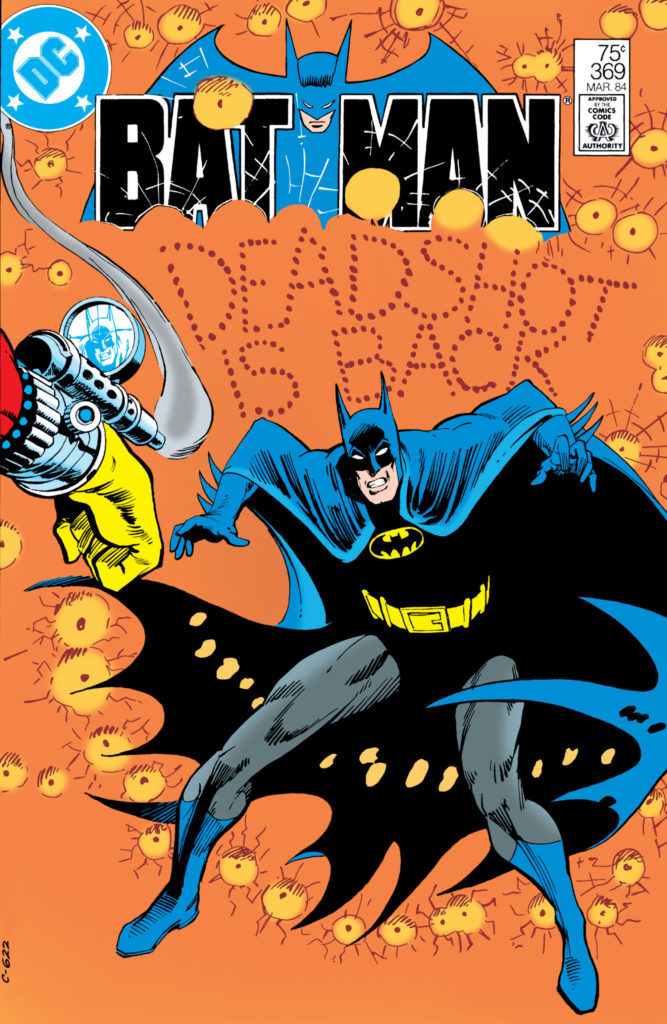 It’s not long before the precocious Deadshot pops back up again in Batman’s world. In Batman #369 (by Doug Moench, Don Newton, Alfredo Alcala, and Adrienne Roy, March 1984) and Detective Comics #536 (Moench, Gene Colan, Bob Smith, and Roy, March 1984), Floyd, once again free from prison, accepts a lucrative hit on none other than Alfred and his daughter Julia Pennyworth. Deadshot attacks them in Montreal, which brings the Dark Knight a-calling. Shortly thereafter, Batman once again saves the day and busts Deadshot, who makes a false claim that Julia’s recently-deceased adoptive dad was behind the hit. En route to jail, Deadshot escapes into the Montreal sewers, prompting Alfred and Julia to chase after him. Eventually, Batman, Alfred, and Julia take down Deadshot and the real perps, a Syrian terrorist organization comprised of art thieves.
It’s not long before the precocious Deadshot pops back up again in Batman’s world. In Batman #369 (by Doug Moench, Don Newton, Alfredo Alcala, and Adrienne Roy, March 1984) and Detective Comics #536 (Moench, Gene Colan, Bob Smith, and Roy, March 1984), Floyd, once again free from prison, accepts a lucrative hit on none other than Alfred and his daughter Julia Pennyworth. Deadshot attacks them in Montreal, which brings the Dark Knight a-calling. Shortly thereafter, Batman once again saves the day and busts Deadshot, who makes a false claim that Julia’s recently-deceased adoptive dad was behind the hit. En route to jail, Deadshot escapes into the Montreal sewers, prompting Alfred and Julia to chase after him. Eventually, Batman, Alfred, and Julia take down Deadshot and the real perps, a Syrian terrorist organization comprised of art thieves.
 We next see Deadshot along with dozens of other super-villains in the classic Crisis on Infinite Earths—and similarly along with dozens of other super-villains in Batman #400. In Crisis, The Creeper bests Deadshot. In Batman #400, Talia al Ghul gets the better of Deadshot. And that’s all she wrote for the character’s Earth-1 and Earth-2 existence. The Crisis sweeps it all away and delivers the Modern Age of comics. Deadshot might be a bit player in the Golden Age, Silver Age, and Bronze Age, but, as we will see, Deadshot officially joins the big leagues after 1986.
We next see Deadshot along with dozens of other super-villains in the classic Crisis on Infinite Earths—and similarly along with dozens of other super-villains in Batman #400. In Crisis, The Creeper bests Deadshot. In Batman #400, Talia al Ghul gets the better of Deadshot. And that’s all she wrote for the character’s Earth-1 and Earth-2 existence. The Crisis sweeps it all away and delivers the Modern Age of comics. Deadshot might be a bit player in the Golden Age, Silver Age, and Bronze Age, but, as we will see, Deadshot officially joins the big leagues after 1986.
In the rebooted post-Crisis continuity, all of Deadshot’s previous history is more or less kept intact. However, for the first time ever, Deadshot branches-out, leaving his role as B-list Batman rogue to become a DCU journeyman that is paradoxically both a sympathetic loving father and a stone cold sociopath who dwells in the darkest reaches of comic book villainy. Deadshot’s first Modern Age appearance is in the Legends crossover (by John Ostrander, Len Wein, John Byrne, Karl Kesel, and Tom Ziuko, November 1986 to May 1987), which also debuts the Suicide Squad, a team with which Deadshot will be forever associated. The Suicide Squad is a team of rotating incarcerated super-villains forced to undertake secret missions for the US military. They are controlled by Task Force X, a clandestine government organization run by the notorious Amanda Waller. The Suicide Squad program supposedly offers super-villains a clean slate in exchange for joining, but the devious Waller will rarely ever grant the prize, sending her “heroes” on mission after deadly mission. Interestingly enough, in Legends, Waller does honor her promise, but Deadshot shows his masochistic nature, choosing to remain on the team. This is the first inkling of Floyd’s personal death-wish—a compulsive desire to be killed in an over-the-top way. Deadshot also shows his sadistic side as well as he has no qualms about executing his own teammates. And thus begins Ostrander’s start with the Suicide Squad and Deadshot, an excellent run that will span nearly six years.
 Suicide Squad #1-4 (by John Ostrander, Luke McDonnell, Karl Kesel, and Carl Gafford, May 1987-August 1987) begins the legendary development of Deadshot’s character. In Louisiana, Deadshot joins his fellow Bell Reve Penitentiary inmates—Bronze Tiger, Captain Boomerang, Enchantress, Nemesis, Nightshade, Plastique, Rick Flag, Karin Grace, and Mindboggler—on the first Suicide Squad lineup. Even in the first four issues of the highly acclaimed series, the team changes lineups and suffers losses (a trend that will continue for decades to come), as they face-off against the aptly named Jihadist group known as The Jihad and then some Darkseid cronies. We see Deadshot, when told to take some one down, use the most brutal and damaging force possible. Even given plenty of non-lethal options, this sick puppy will choose to kill, kill, kill. Amazingly, Deadshot then disguises himself as racist ideologue William Hell (a childhood friend of his) in order to discredit the asshole at a White Power rally.
Suicide Squad #1-4 (by John Ostrander, Luke McDonnell, Karl Kesel, and Carl Gafford, May 1987-August 1987) begins the legendary development of Deadshot’s character. In Louisiana, Deadshot joins his fellow Bell Reve Penitentiary inmates—Bronze Tiger, Captain Boomerang, Enchantress, Nemesis, Nightshade, Plastique, Rick Flag, Karin Grace, and Mindboggler—on the first Suicide Squad lineup. Even in the first four issues of the highly acclaimed series, the team changes lineups and suffers losses (a trend that will continue for decades to come), as they face-off against the aptly named Jihadist group known as The Jihad and then some Darkseid cronies. We see Deadshot, when told to take some one down, use the most brutal and damaging force possible. Even given plenty of non-lethal options, this sick puppy will choose to kill, kill, kill. Amazingly, Deadshot then disguises himself as racist ideologue William Hell (a childhood friend of his) in order to discredit the asshole at a White Power rally.
 Not long after the debut of the Suicide Squad, Ostrander continues Deadshot’s tale in the pages of Firestorm Vol. 2 #64 and Firestorm Vol. 2 Annual #5 (October 1987). In this mini-arc, Firestorm vows to eradicate all of the nuclear warheads on the planet, so the US government sends Captain Atom and the Suicide Squad—Rick Flag, Killer Frost, Deadshot, Captain Boomerang, Multiplex, and Slipknot—to fight him. The Justice League then gets involved in what becomes an all-out war against Parasite, who has been unleashed by the Suicide Squad. Eventually, Firestorm combats Russia’s own nuclear man Pozhar and merges with him.
Not long after the debut of the Suicide Squad, Ostrander continues Deadshot’s tale in the pages of Firestorm Vol. 2 #64 and Firestorm Vol. 2 Annual #5 (October 1987). In this mini-arc, Firestorm vows to eradicate all of the nuclear warheads on the planet, so the US government sends Captain Atom and the Suicide Squad—Rick Flag, Killer Frost, Deadshot, Captain Boomerang, Multiplex, and Slipknot—to fight him. The Justice League then gets involved in what becomes an all-out war against Parasite, who has been unleashed by the Suicide Squad. Eventually, Firestorm combats Russia’s own nuclear man Pozhar and merges with him.
Suicide Squad #5-8 (continued by Ostrander et al, September 1987-December 1987) sees the team—joined by Penguin—venture into Soviet Russia to combat the KGB! We learn that Deadshot is fluent in Russian and a communist. When the US government catches wind of Waller’s mission, she is forced to abort. The Suicide Squad gets out of dodge, but Nemesis is captured by The People’s Heroes. Back behind Belle Reve bars, Deadshot and his Squad pals deal with the machinations of Derek Tolliver, Task Force X’s dubious NSC liaison. The team eagerly wants to rescue Nemesis, but Waller won’t (and can’t) give the green light. In a Bell Reve therapy session, Deadshot kisses his doctor, Marnie Herrs. A bit of sexual tension will last between the two, moving forward.
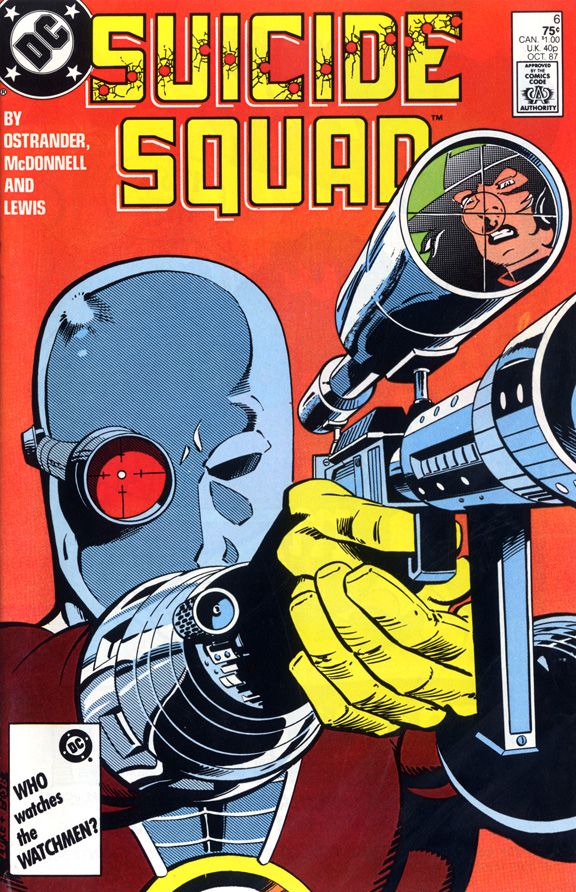 Deadshot, as part of his new journeyman status with the Suicide Squad, obviously shows up for DC’s next big mega-crossover Millennium (1987-1988), in which we discover that loved ones and close friends of the superheroes have been replaced by killer android Manhunters. (This is basically Marvel’s Secret Invasion done exactly twenty years earlier.) The Manhunters’ goal is to stop the Oanian/Zamaronian “Millennium Project,” a plan to birth a new superhero team that will defend the galaxy. The heroes learn about the “Millennium Project” and the Manhunter plot at a special meeting called to order by Hal Jordan at the Green Lantern Citadel. After debriefing, the war against the Manhunters officially begins on Earth and in outer space, with hundreds of heroes and villains involved, including the Suicide Squad. In the pages of Ostrander’s Suicide Squad #9 (January 1988), Deadshot and company face off against the Manhunters, finding that one of their own, Karin Grace has been replaced. Floyd gets a new opportunity to still be the bad boy that he is, but to also fight for a heroic cause. The antihero shines through here.
Deadshot, as part of his new journeyman status with the Suicide Squad, obviously shows up for DC’s next big mega-crossover Millennium (1987-1988), in which we discover that loved ones and close friends of the superheroes have been replaced by killer android Manhunters. (This is basically Marvel’s Secret Invasion done exactly twenty years earlier.) The Manhunters’ goal is to stop the Oanian/Zamaronian “Millennium Project,” a plan to birth a new superhero team that will defend the galaxy. The heroes learn about the “Millennium Project” and the Manhunter plot at a special meeting called to order by Hal Jordan at the Green Lantern Citadel. After debriefing, the war against the Manhunters officially begins on Earth and in outer space, with hundreds of heroes and villains involved, including the Suicide Squad. In the pages of Ostrander’s Suicide Squad #9 (January 1988), Deadshot and company face off against the Manhunters, finding that one of their own, Karin Grace has been replaced. Floyd gets a new opportunity to still be the bad boy that he is, but to also fight for a heroic cause. The antihero shines through here.
Following the Millennium crossover, in Ostrander’s Suicide Squad #10 (February 1988), Batman learns about what the Suicide Squad is and he’s not happy about it. Already down South following the events of Millennium, Batman dons the Matches Malone disguise and infiltrates the Squad’s headquarters as an inmate in Belle Reve. While there, Batman fights the Suicide Squad and beats the entire team before confronting Waller, who threatens that she can easily discover his secret identity if she wants to. Batman backs down.
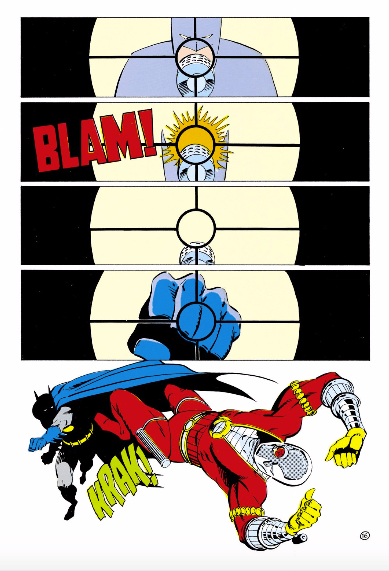 Next, Deadshot’s journey with the Suicide Squad continues in another small crossover, featuring Justice League International #13 (by Keith Giffen, JM DeMatteis, et al, May 1988) and Suicide Squad #13 (by the Ostrander team, May 1988).
Next, Deadshot’s journey with the Suicide Squad continues in another small crossover, featuring Justice League International #13 (by Keith Giffen, JM DeMatteis, et al, May 1988) and Suicide Squad #13 (by the Ostrander team, May 1988).
In JLI #13, the Suicide Squad, against Waller’s orders, attempts a rescue of Nemesis in Russia, but the JLI is ready and waiting for them at the request of the president, who fears an international incident. The JLI and Suicide Squad square-off, but the former eventually comes to realize that Nemesis is wrongly imprisoned. The fight ends with a truce and team-up to save Nemesis, although a disgruntled Batman nearly cripples Rick Flag and quits the JLI (for the second time). Despite the protesting of the Russian government, Nemesis is given asylum at the JLI Russian Embassy and then secretly returned to the States.
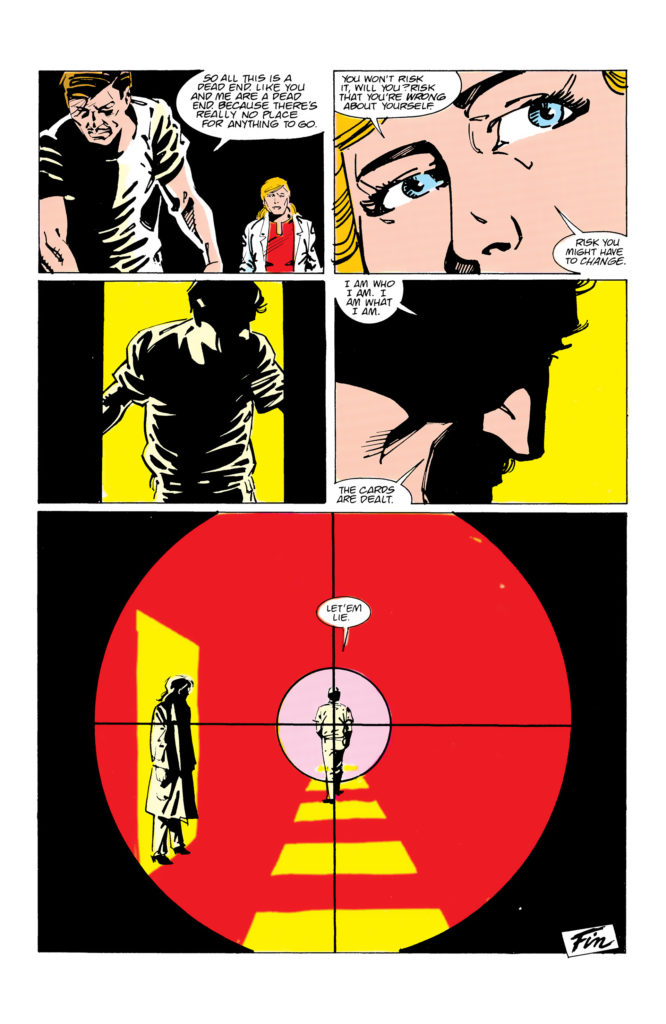 Ostrander and McDonnell’s Suicide Squad #14-16 (June 1988-October 1988) details the “Nightshade Odyssey”—which sees the Squad explore the Nightshade Dimension (aka The Land of the Nightshades), a world of darkness and horror linked to team member Nightshade—and “Manhattan Massacre”—a single issue featuring the revenge attempt of the Jihad. In the first part, a chaotic battle against the demonic Incubus goes south when a hotheaded Deadshot shoots Incubus’ mortal host in the head, which sucks everyone into a black hole-like portal that takes them to the Zero-Zone (which is linked to the Phantom Zone). This eventually leads to Shade the Changing Man joining the team. Shortly thereafter, in the second part, much to Deadshot’s pleasure, the Squad gets a bloody rematch against the Jihad.
Ostrander and McDonnell’s Suicide Squad #14-16 (June 1988-October 1988) details the “Nightshade Odyssey”—which sees the Squad explore the Nightshade Dimension (aka The Land of the Nightshades), a world of darkness and horror linked to team member Nightshade—and “Manhattan Massacre”—a single issue featuring the revenge attempt of the Jihad. In the first part, a chaotic battle against the demonic Incubus goes south when a hotheaded Deadshot shoots Incubus’ mortal host in the head, which sucks everyone into a black hole-like portal that takes them to the Zero-Zone (which is linked to the Phantom Zone). This eventually leads to Shade the Changing Man joining the team. Shortly thereafter, in the second part, much to Deadshot’s pleasure, the Squad gets a bloody rematch against the Jihad.
Finally, due to his ever-increasing popularity, Deadshot is granted his very own solo series for the first time ever! Deadshot #1-4 (by Ostrander and McDonell, who are joined by Kim Yale, November 1988-December 1988). This series is notable because Ostrander and Yale start fleshing-out Floyd’s most defining traits, including expanding upon a running thread from Suicide Squad: his macabre death-wish. Deadshot, often shown as being bummed when he isn’t slaughtered on missions in the pages of Suicide Squad, will double down on this mentality after his solo series concludes. The Deadshot solo series not only further expands upon Deadshot’s character, but it also reveals that Floyd has a young son named Edward Lawton. Unfortunately, poor Edward gets raped and killed before story’s end. Yikes. Shaken to his core, Deadshot becomes even more detached from humanity, accepting his fate as a blind vengeful killing machine in the Punisher sense. In the end, Floyd winds up shooting and crippling his own mother. Deadshot also finally tells us what makes Floyd tick via a very troubled origin that dates back to his twisted childhood. When young Floyd’s abusive dad cheated on his mom, she tasked Floyd’s brother Eddie with killing their adulterous pop. Eddie wound up shooting their dad, paralyzing him for life. In the ensuing chaos, Floyd accidentally shot Eddie dead.
The tragedy of the death of Floyd’s son and messed-up family affairs will continue to haunt him as his narrative continues uninterrupted through over fifty-five ongoing issues of Suicide Squad, from 1988 to 1990. In the big chunk of Suicide Squad #22-43, Ostrander and Yale guide Deadshot through the sinister underworld of corruption and malice that is the late 80s DCU. In Suicide Squad #22 (December 1988), the now completely unstable Deadshot assassinates a US senator and gets in a dogfight with Rick Flag, which leads to an emotional scene where Deadshot breaks down and gets riddled with bullets in front of the Lincoln Memorial. But our boy Floyd is a survivor, and he comes back for the “Phoenix Gambit” arc from Suicide Squad #40-43 (April 1990-July 1990). In this tale, Amanda Waller, who has been stripped of leadership duties and jailed, gets out of prison to lead the now freelance (non-government-sanctioned) Suicide Squad into Count Vertigo’s civil-war-torn homeland of Vlatava. However, since Batman has given the Squad nothing but grief in the past, they not only want his blessing, but his help as well. Therefore, Waller cuts a deal that allows Batman to help choose the new members of the Squad in exchange for aiding him in the capture of a fugitive Vlatavan murderer. Batman personally re-recruits Poison Ivy and Ravan into the Squad and they all head out to Vlatava. Meanwhile, when a serial killer steals Deadshot’s costume, he is “forced” to murder someone that essentially looks just like him. After the dust settles, a disillusioned Waller leaves the Suicide Squad. (Don’t worry, she’ll be back.) For the first time since before the Crisis, though, Deadshot is legitimately freelance—although not solo as he remains with the Squad.
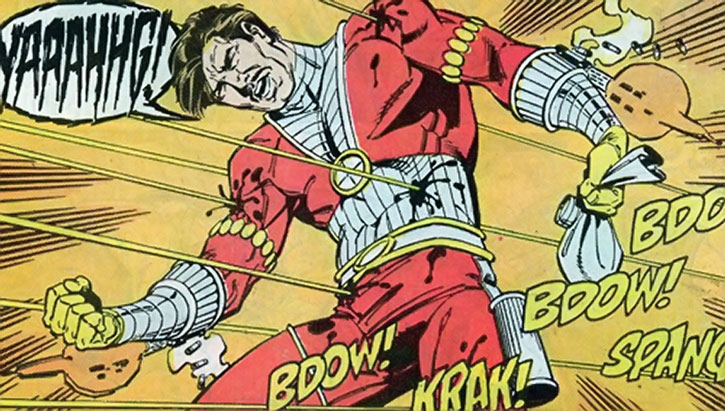
After his costume is returned by none other than Batman’s mentor Henri Ducard (!), Floyd chooses to leave the bullet hole in his mask—the hole through which he put a slug into his copycat’s head. Shaken by the altercation with his doppelgänger and with a new Suicide Squad status-quo, Floyd reconsiders what it means to be Deadshot. Despite still remaining active with the team, Deadshot stops referring to himself as such and begins referring to himself by his civilian name. Floyd will roll with this from Suicide Squad #44 through Suicide Squad #61 (August 1990-January 1992) as he goes on successful mission after successful mission.
At the beginning of 1992, Deadshot appears in the War of Gods crossover—in Wonder Woman Vol. 2 #61 (by George Pérez and Jill Thompson, January 1992) and a few War of the Gods issues (by George Pérez and Russell Braun, September 1991-January 1992)—a big event where Circe manipulates the ancient gods to begin a massive battle-royale on Earth. While the temporarily split Greek gods fight their Roman counterparts, Earth’s heroes (and the Suicide Squad) take on the combined force of the Norse gods, Egyptian gods, Babylonian gods, African gods, and Thanagarian gods.
Following War of the Gods is Suicide Squad #59-62—the “Legerdemain” arc (by John Ostrander, Kim Yale, Geof Isherwood, Robert Campanella, and Tom McCraw, November 1991-January 1992). In this unbelievably complex plots, the Saddam Hussein-esque ex-dictator of Qurac is being held at the Guantanamo Bay-esque Blood Island, which is where the Suicide Squad is supposedly stationed. Both Israeli and Arab metahuman teams are trying to get to the ex-dictator Marlo first (the former trying to assassinate, the latter trying to rescue). Meanwhile, Batman, Aquaman, and Superman have converged on Blood Island because they believe that they have found evidence linking Amanda Waller to Ray Palmer’s recent death. The heroes clash with the Israelis and Arabs on Blood Island, but realize that the Suicide Squad isn’t there. However, the Squad arrives when Waller discovers the entire altercation on Blood Island is a CIA setup in which the US government is trying to deliver Marlo back into the hands of the Quracis. Anyway, the new Atom dies and Ray Palmer makes his return, revealing that he had faked his death in order to go undercover in an investigation into microscopic rogue CIA agents. Notably, there is an excellent (albeit slightly continuity-problematic) nasty confrontation between Batman and Oracle in issue #59.
Suicide Squad #63-66 (February 1992-June 1992) ends Ostrander’s brilliant long run on the series, pitting the Suicide Squad up against an alternate Suicide Squad and rival Task Force X group. For six years, Ostrander and a rotating team of partnered creators delivered some of the best comics of the 20th century—and at the heart of those comics is Deadshot.
Thanks for reading! Join us next week for the second part of this Deadshot retrospective where we pick up a year later, when Floyd returns in 1993’s “Kobra Chronicles” by Mike Baron and Gary Barker.
